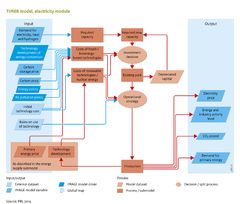Energy conversion/Policy issues: Difference between revisions
Jump to navigation
Jump to search
No edit summary |
No edit summary |
||
| Line 1: | Line 1: | ||
{{ComponentPolicyIssueTemplate | {{ComponentPolicyIssueTemplate | ||
|Status=Publishable | |Status=Publishable | ||
|Reference=Kruyt et al., 2009; PBL, 2012; | |Reference=Kruyt et al., 2009; PBL, 2012; | ||
|Description=The conversion model may be used to generate scenarios with and without climate policy. The results according to a typical baseline scenario are shown in the figure below. At the moment, coal is by far the most important feedstock for power generation, globally speaking. In high-income regions, the contribution of coal faces competition from natural gas. In emerging economies, such as those of China and India, however, coal is still by far the largest resource used. The baseline scenario projects coal use to expand in the future. The underlying reasons for this expansion are the fast increase in electricity use in these emerging economies, and the stronger price increases for natural gas than for coal. At the same time, wind power and biomass-fired power plants rapidly expand their total capacity, on a global scale. | |Description=The conversion model may be used to generate scenarios with and without climate policy. The results according to a typical baseline scenario are shown in the figure below. At the moment, coal is by far the most important feedstock for power generation, globally speaking. In high-income regions, the contribution of coal faces competition from natural gas. In emerging economies, such as those of China and India, however, coal is still by far the largest resource used. The baseline scenario projects coal use to expand in the future. The underlying reasons for this expansion are the fast increase in electricity use in these emerging economies, and the stronger price increases for natural gas than for coal. At the same time, wind power and biomass-fired power plants rapidly expand their total capacity, on a global scale. | ||
|Example=Model analyses show that a high proportion of emission reductions would be achieved through supply side changes.The figure below shows the capacity for different supply side options under the baseline scenario and various pathways consistent with the 2 <sup>o</sup>C climate change target. Although the share of unabated fossil-fuel use is still 80% of total primary energy under the baseline scenario (see above), by 2050 this would need to be around 15% to 20% according to the 2 <sup>o</sup>C scenarios. The results show that pathways can be identified in which the remaining energy comes from bio-energy, other renewable energy, nuclear energy, and from fossil-fuel energy combined with [[hasAcronym::CCS]]. There is flexibility in the choice of these options, as illustrated here in the Decentralised Solutions and Global Technology pathways with very different patterns for nuclear power and renewable energy. In the IMAGE model, however, under nearly all scenarios, the combination of bio-energy and CCS, and CCS in general, plays a critical role in achieving the 2 <sup>o</sup>C target | |Example=Model analyses show that a high proportion of emission reductions would be achieved through supply side changes.The figure below shows the capacity for different supply side options under the baseline scenario and various pathways consistent with the 2 <sup>o</sup>C climate change target. Although the share of unabated fossil-fuel use is still 80% of total primary energy under the baseline scenario (see above), by 2050 this would need to be around 15% to 20% according to the 2 <sup>o</sup>C scenarios. The results show that pathways can be identified in which the remaining energy comes from bio-energy, other renewable energy, nuclear energy, and from fossil-fuel energy combined with [[hasAcronym::CCS]]. There is flexibility in the choice of these options, as illustrated here in the Decentralised Solutions and Global Technology pathways with very different patterns for nuclear power and renewable energy. In the IMAGE model, however, under nearly all scenarios, the combination of bio-energy and CCS, and CCS in general, plays a critical role in achieving the 2 <sup>o</sup>C target ( [[PBL, 2012]]). | ||
}} | }} | ||
Revision as of 14:54, 16 December 2013
Parts of Energy conversion/Policy issues
| Component is implemented in: |
|
| Related IMAGE components |
| Projects/Applications |
| Models/Databases |
| Key publications |
| References |
